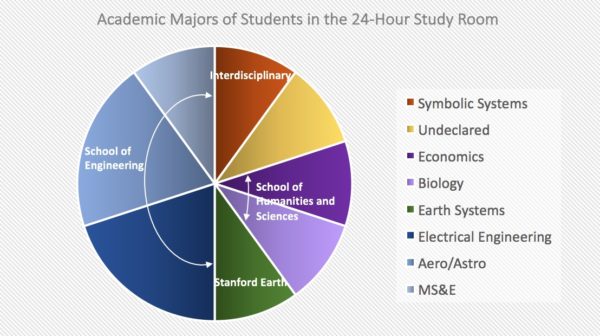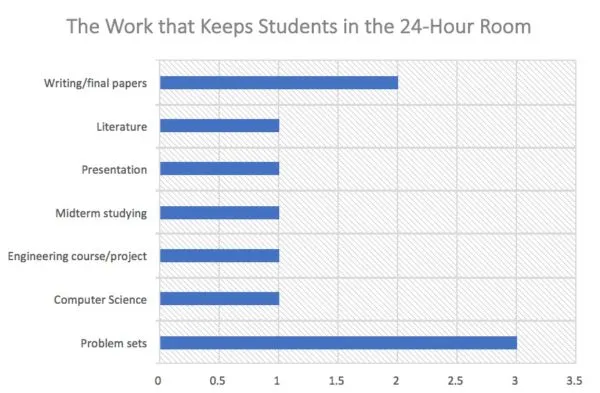The later weeks of the quarter often feel inexplicably isolating. Deadlines loom; the pressure of the last few midterms fuses with the incoming typhoons of finals. You spend hour after hour in the library, surrounded by strangers, engulfed by silence and the palpable tension.
And so, I decided, why not head to the 24-hour room in the wee hours of the morning and learn about the lives of those that surrounded me? In other words — what keeps a Stanford student up at night, and in the 24-hour room in particular?
Part 1: The room where it happens
I arrived in the Lathrop 24-hour room at around 1:20 a.m. The room was mostly silent, save for the sound of zippers, ruffling papers, and the occasional door slam as students slowly tricked out. All but two people were occupied with some form of schoolwork — one was pacing erratically, and the other had fallen asleep with his head resting on his keyboard.
The thought of approaching (and thus necessarily interrupting) each of these people terrified me.
Upon closer examination, however, the 24-hour room was not as sterile and lifeless at it seemed. Each occupant had created a sort of nook for themselves; much as the uniformity of office cubicles is broken by personal tokens and framed photos, the workstations reflected personality. Some had clearly settled in for the long haul and removed their shoes; others had created barricades of snacks and water bottles. One person I interviewed (a first-year master’s student in electrical engineering) reported that he regularly spends nine hours per day in the 24-hour study room; another student, an undeclared junior, had spent six hours in the room that day.
Each student I interviewed was surprisingly kind about my interrupting them. There was almost a quiet understanding between fellow night-dwellers of the 24-hour study room; a silent recognition of someone caught in the same late-quarter struggle. And it felt almost reassuring to know that, though we too often study alone, we have, in fact, more company than we realize.
Part 2: The 24-hour room by the numbers
The less subjective portion of my visit comes in the form of numbers — I hesitate, however, to draw any stringent conclusions, since a single visit (and a sample size of 10) is obviously not sufficient for any sort of analysis. But I think the numbers paint a snapshot: of the kinds of student who end up in the 24-hour study room late at night, and the kind of work they might be doing.

The night I visited the 24-hour study room, half of the students belonged to the School of Engineering — only a slight (and insignificant) overrepresentation, considering that engineering students comprise 31.3% of the total student population.
I was at first surprised that there were not more computer scientists, given the stories that I’d heard of late-night coding sessions (and the many nights that I had spent coding myself). However, given that there are more notable — or rather, more infamous — programming locations, such as Huang Basement, it wasn’t entirely surprising that CS was underrepresented in Lathrop. In future experiments (which I hope for the sake of my own sleep schedule that others will conduct), it will be interesting to note the differences in academic representation in various late-night study areas.
On the other hand, since Lathrop is closer to the graduate schools, just under half of the students were graduate students:

Finally, a survey of the types of work that kept students late at night found a wide array of results. There is, indeed, no single source of massive work, although problem sets are of course well represented. Even the small snapshot of a single 4 a.m. night (morning?) reveals much variety — from the aeronautics and astronautics freshman who was working on his SLE final paper to the Symbolic Systems major working on literature, the work that keeps Stanford awake at night makes it clear that Stanford students are impossible to categorize and brilliantly diverse.

But even more crucial to remember is that, like you, they’re awake. Like you, they’re cramming and crunching problem sets in the 24-hour room. And as Dead Week arrives, no matter how lonely you may feel, remember that you are not alone.
You can find Xinlan Emily Hu at the Lathrop 24-hour study room or at xehu ‘at’ stanford.edu.